When the Canes Ruled the Draft: The Year Miami Had Six First-Rounders

Toward the end of February 2004, the entire football world descended on the University of Miami for the Hurricanes’ pro day. Some estimate there were several hundred people in attendance, including coaches, executives, and scouts from every organization, it seemed. When Jonathan Vilma arrived, he couldn’t find parking—for his own showcase. “I was like three hours early, too,” he says.
Pundits had already started speculating that as many as six Hurricanes could go in the first round of the 2004 NFL draft. Not only would six of them go in the first round—setting an NFL record—they would all go in the first 21 picks. To this day, no school, not even Nick Saban’s Alabama, has ever produced that much talent at the top of a single draft.
Now 15 years later, enough time has passed that we can properly assess that 2004 Miami draft class. A few of the players became stars, a few developed into solid starters, and a few were, well … it got complicated. For none of the six would their careers go exactly as planned. No, looking back, this 2004 Miami draft class might not have been the greatest ever. But it might have been the class that best encapsulates the draft experience. The Hurricanes of 2004 showed us just how difficult it is to evaluate prospects, and how capricious the draft can be.
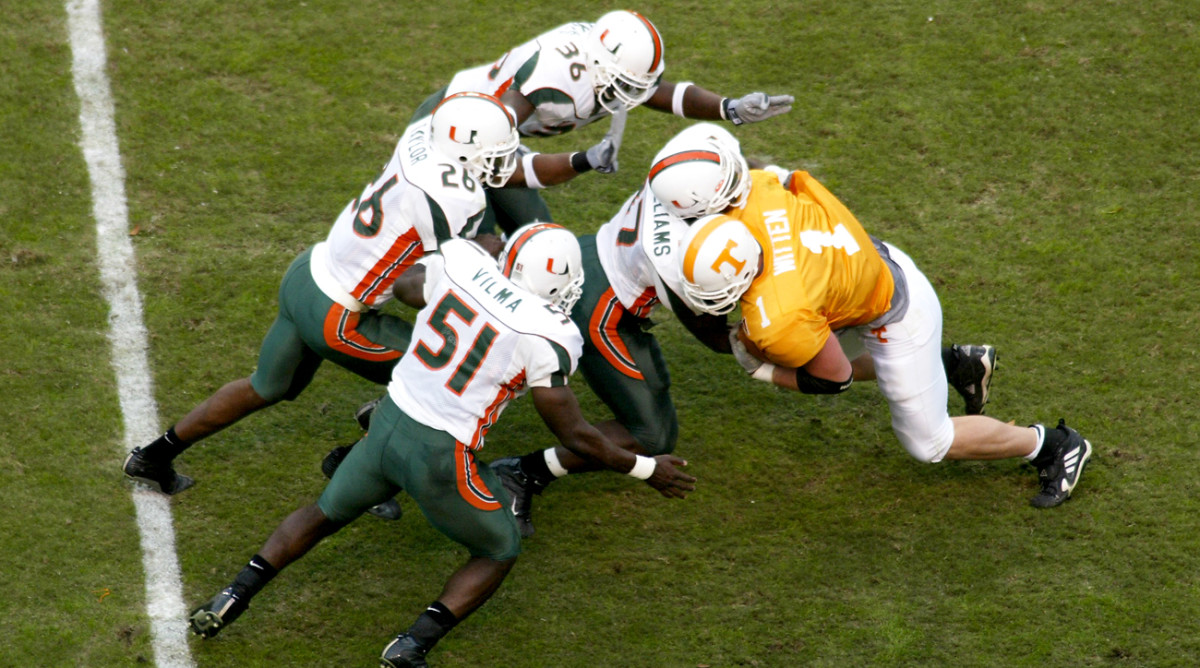
Back at that pro day, though, all six of these Miami prospects looked like solid bets. When the draft arrived, teams were practically climbing over one another to pick one of them.
Washington, the owner of the fifth pick, had sent a contingent of about a half-dozen people to that Miami pro day. Among them was Vinny Cerrato, the team’s vice president of football operations. He remembers that the team was considering just two players for that No. 5 pick: Miami safety Sean Taylor, and Miami tight end Kellen Winslow II.
The staff was split, Cerrato recalls. The offensive coaches wanted Winslow, and the defensive coaches wanted Taylor. In case of a tie, Joe Gibbs, the coach and team president, would likely make the call, and Gibbs was an offensive-minded coach who loved athletic tight ends. Years earlier, when Gibbs was working as the Chargers’ offensive coordinator, he coached a young Kellen Winslow Sr. Under Gibbs’ watch, in 1980, Winslow Sr. had the best season of his career: 89 catches for 1290 yards and nine touchdowns.
Naturally, Washington brought Winslow II in for an official visit. But it didn’t go so well. One morning, Cerrato recalls, Winslow was supposed to meet Gibbs for breakfast and didn’t show. Gibbs discovered that Winslow was up in his room, sleeping. Later on, when Winslow visited the facility, he fell asleep again. “It wasn’t a good first impression, let me just say that,” Cerrato says. It also didn’t help that Winslow hired as his agents the Poston brothers, who had recently clashed with the team during LaVar Arrington’s contract negotiations. Arrington had accused the team of cheating him out of $6.5 million.
Even so, the Washington decision-makers were still split between Winslow and Taylor. Finally, about a week before the draft, Gibbs gathered everyone to watch the 2003 national championship game between Miami and Ohio State. First they watched Winslow’s tape—he had 11 catches for 122 yards and a touchdown that game—and the room was buzzing. Then they watched Taylor’s tape. He made two interceptions and a number of big plays. After that, Cerrato says, the offensive coaches were adamant:
Joe, we’ve got to take Sean Taylor.
Of the six Hurricanes prospects, Taylor was the athletic freak. Andreu Swasey, the Miami strength coach at the time, remembers Taylor weighing about 230-plus pounds and running a sub 4.4 40-yard dash. A free safety, he was both an enforcer and a nimble cover man. Receivers, tight ends, running backs—Taylor could run with anyone. And level them, too.
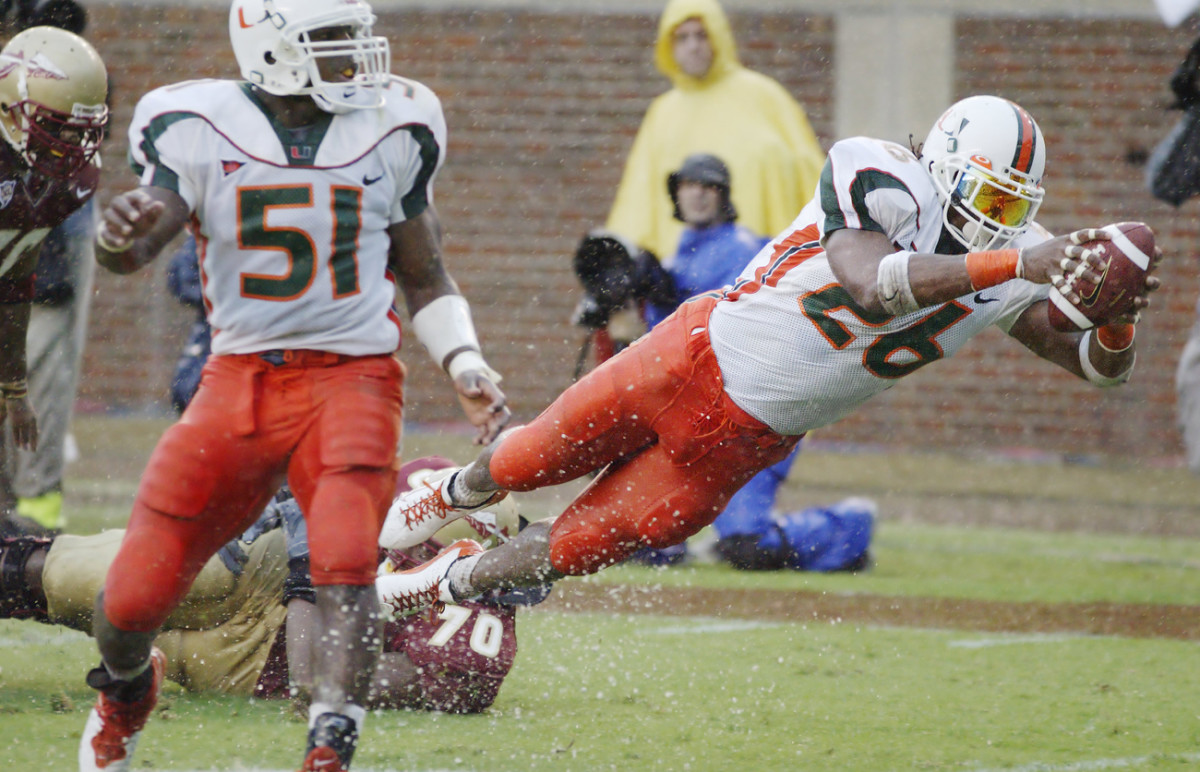
Washington needed a playmaker in its secondary. That offseason the team had traded Pro Bowl corner Champ Bailey to the Broncos for Pro Bowl running back Clinton Portis. He was also a former Miami Hurricane, and he had an opinion on the Taylor vs. Winslow debate, too. Portis had been in Gibbs’ ear, urging him to take Taylor.
When draft day arrived, Gibbs had decided: Taylor would be the pick. But at the last minute, the Browns, owners of the No. 7 pick, called asking to trade up. Butch Davis, Cleveland’s coach and EVP, had previously been the head coach at Miami and had recruited all six of these Hurricane prospects out of high school. He knew them better than anyone in the NFL perhaps, and he was enamored with the same two that Gibbs was: Taylor and Winslow.
Cerrato says the Browns were coming for Taylor. Davis is more diplomatic about it: “It was probably about 60-40 that we would’ve taken Sean [over Winslow],” he says. He wanted to know what it’d cost to get Taylor. But Washington wasn’t budging. “There was no interest whatsoever,” Cerrato says. “We wanted Sean Taylor.”
No. 5, Washington Redskins: Sean Taylor, safety
It turned out that Washington wasn’t the only team the Browns had contacted about trading up. They called the Giants about the No. 4 pick, too, apparently so they could leapfrog Washington and pick Sean Taylor themselves. Ernie Acorsi, the Giants’ general manager at the time, told Tom Callahan, the author of the book The GM, that the Browns offered him a second-round pick to move up. “… I almost did it,” Accorsi recalled. “But I stopped and thought, You know what? If I drop down to pick up a second, and now Cleveland makes the Manning trade, I’ll kill myself.” Instead, Accorsi worked out the “Manning trade” himself. He took Phillip Rivers at No. 4 and flipped him to the Chargers for Eli Manning, who had made it clear he did not want to play for San Diego, even though the Chargers had selected him No. 1.
After Washington snatched up Taylor at No. 5, the Browns turned their attention to Kellen Winslow. This time they wanted to ensure they got their guy, so they reached out to Detroit, which owned the No. 6 pick. The Lions ultimately agreed to the trade that Accorsi had turned down: Cleveland sent Detroit a second-round pick to move up one spot, from No 7.
That seemed like a high price, but Davis felt the move was worth it to secure Winslow. Remember, Ben Roethlisberger, the Miami (Ohio) quarterback, was still on the board at that point. But the Browns had signed Jeff Garcia that offseason, and they still had Tim Couch on their roster. Apparently the Browns believed they’d be OK at quarterback, although they would release Couch a few months later, after he refused to take a pay cut. “At the time we needed explosive offensive people to surround the quarterback,” Davis says. “You liked all the things that you could do with [Winslow] offensively.”
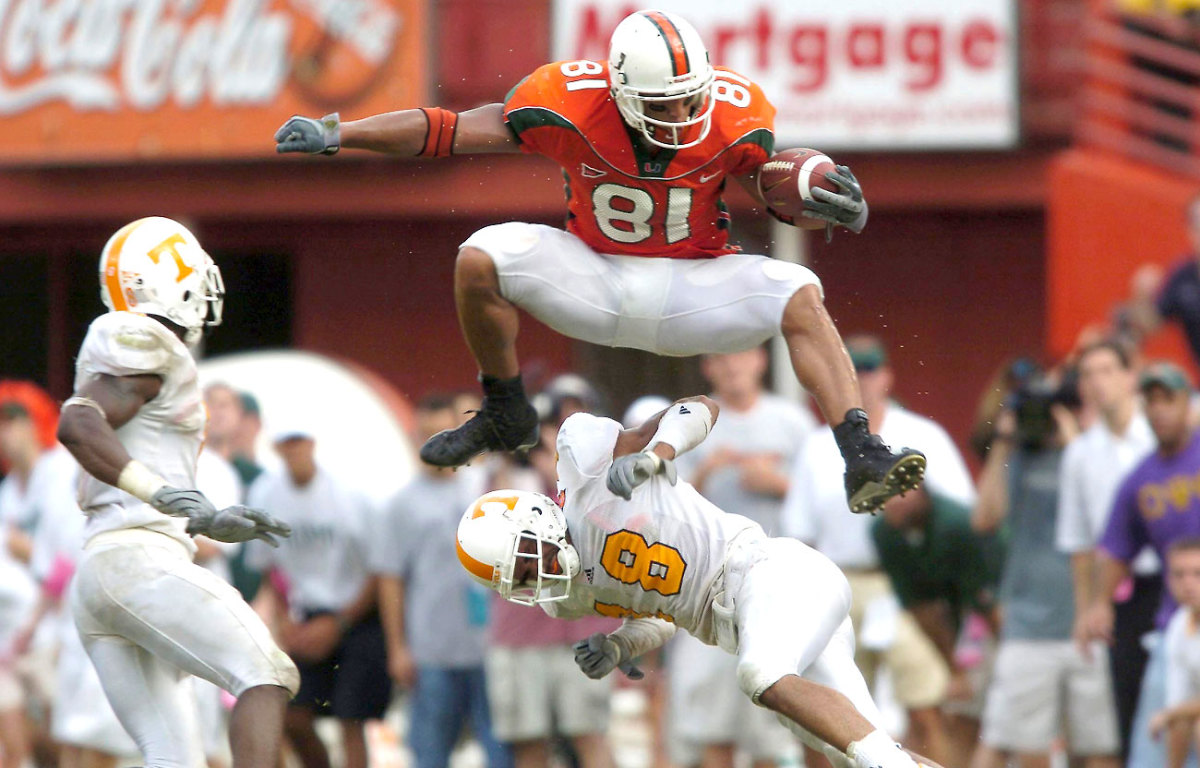
Having recruited him out of high school, Davis also felt he had a good grasp on Winslow the person. The Browns had conducted a routine background check on Winslow leading up to the draft, “and there was nothing that we found out that was any kind of red flag,” Davis says, “other than some of the comments he made.”
Winslow had made the comments in early November 2003, after an emotional loss to Tennessee. During the game, Winslow had stood over and taunted a Tennessee defensive back who appeared to be injured, moments after Winslow had demolished him with a block. Afterward reporters asked Winslow about the play. “It’s war,” Winslow said. “They don’t give a freaking you-know-what about you. They will kill you. They’re out there to kill you, so I’m [going] to kill them. You write that in the paper. You write that. You make money off that.” In a video of the exchange, it appears that someone tried asking Winslow another question. Instead, he doubled down: “Nah, man, I’m pissed! All ya’ll take this down. I’m pissed, man. We don’t care about nobody except this ‘U.’ We don’t. If I didn’t hurt him, he’d hurt me. They were gunning for my legs. I’m going to come right back at them. I’m a f---ing soldier!”
The comments drew criticism and made headlines nationwide. The country was only a few years removed from 9/11, and the Iraq war had begun earlier in the year. People thought it was insensitive for a football player to call the game a “war,” and himself a “solider.”
The Miami coaches asked Winslow to apologize to the team. They gathered everyone in the team meeting room, along with several university and athletic department officials. According to D.J. Williams, one of Winslow’s teammates who was also a member of that 2004 draft class, this is what happened next: “Kellen went up there, and he was supposed to apologize. He took a deep breath. He said, ‘I guess everybody knows why we’re here and what happened last week. They want me to apologize.’ And he goes: ‘… I ain’t f---ing doing it.’ And the athletic director and the president’s face was like, what? Our strength and conditioning coach put his face in his hands and was like, Oh sh--.
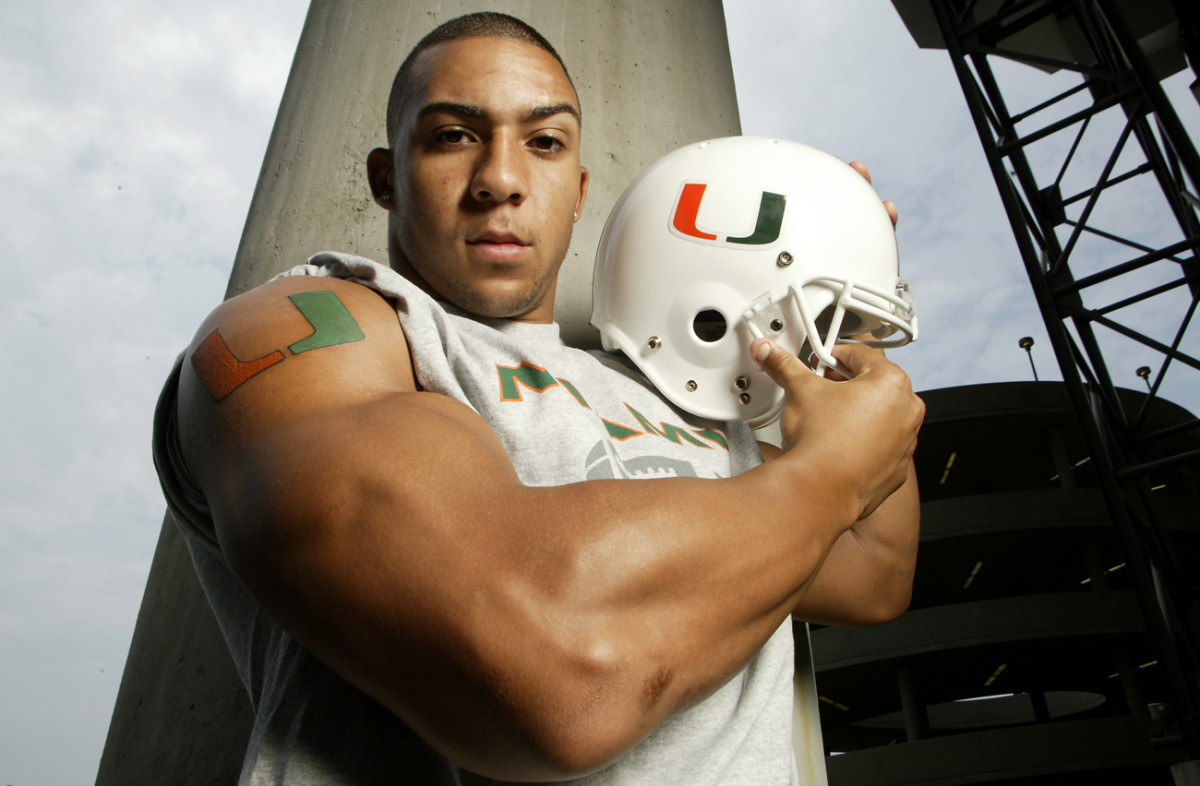
“Kellen’s like, ‘I’m not f---ing doing it!’ He gets louder. He goes, ‘You know why I’m not f---ing doing it?’ He starts pointing guys out on the team: ‘Because you loved that sh--, you loved that sh--, and you loved that sh--. We ain’t no f---ing pussies.’
“And then he goes and sits down. There was silence for about five seconds, and then [coach] Larry Coker was like, ‘Uhh, O.K., break it up.’ And the meeting just ended.”
Winslow’s teammates had seen him like this before. They interpreted it as a manifestation of his competitiveness. The Browns viewed his “soldier” comments the same way. “That was kind of the type of kid he was: unbelievably competitive,” Davis says. “It just solidified what we already knew: This kid wants to win. He was just a competitor.”
No. 6, Cleveland Browns: Kellen Winslow II, tight end
In the lead-up to the draft, many NFL teams had shown interest in Miami’s top two linebackers, Jonathan Vilma and D.J. Williams. But a handful of teams had coveted all three of Miami’s starting linebackers, including Darrell McClover, who was generally considered a late-round prospect. One of those teams was the Jets, owners of the 12th overall pick. They brought in all three of the Miami linebackers, together, for an official pre-draft visit.
During that visit the trio met together with Jets coach Herm Edwards, who asked them questions and gushed over their tape. At one point toward the end of the conversation, Edwards asked Vilma how much he weighed. This was touchy subject. Some people wondered if Vilma was heavy enough to play middle linebacker in the NFL.
If only they’d seen him four years earlier. When Vilma arrived at Miami he had the smarts to play middle linebacker and run a defense, but he lacked the size. He weighed 195 pounds, soaking wet. “Probably more like 190,” Vilma admits now. He wasn’t that fast, either. He ran the 40-yard dash somewhere in the 4.9s as a freshman. When Andreu Swasey, the Hurricanes’ strength coach, put Vilma through one of his first conditioning drills, he vomited halfway through. Once he finished, Swasey pulled him aside and told Vilma he’d be a star. “I was like, ‘I don’t know what you’re talking about, I just threw up,’ ” Vilma recalls. But Swasey had a vision, and he’d worked with stars before. He’d put Vilma on “the Regimen,” the same program that helped Andre Johnson and Ed Reed develop into stars at Miami. “I knew that, on average, I was going to have a guy gain at least 30 pounds of pure lean mass,” Swasey says. He told Vilma to trust the Regimen and that “the weight will come.”
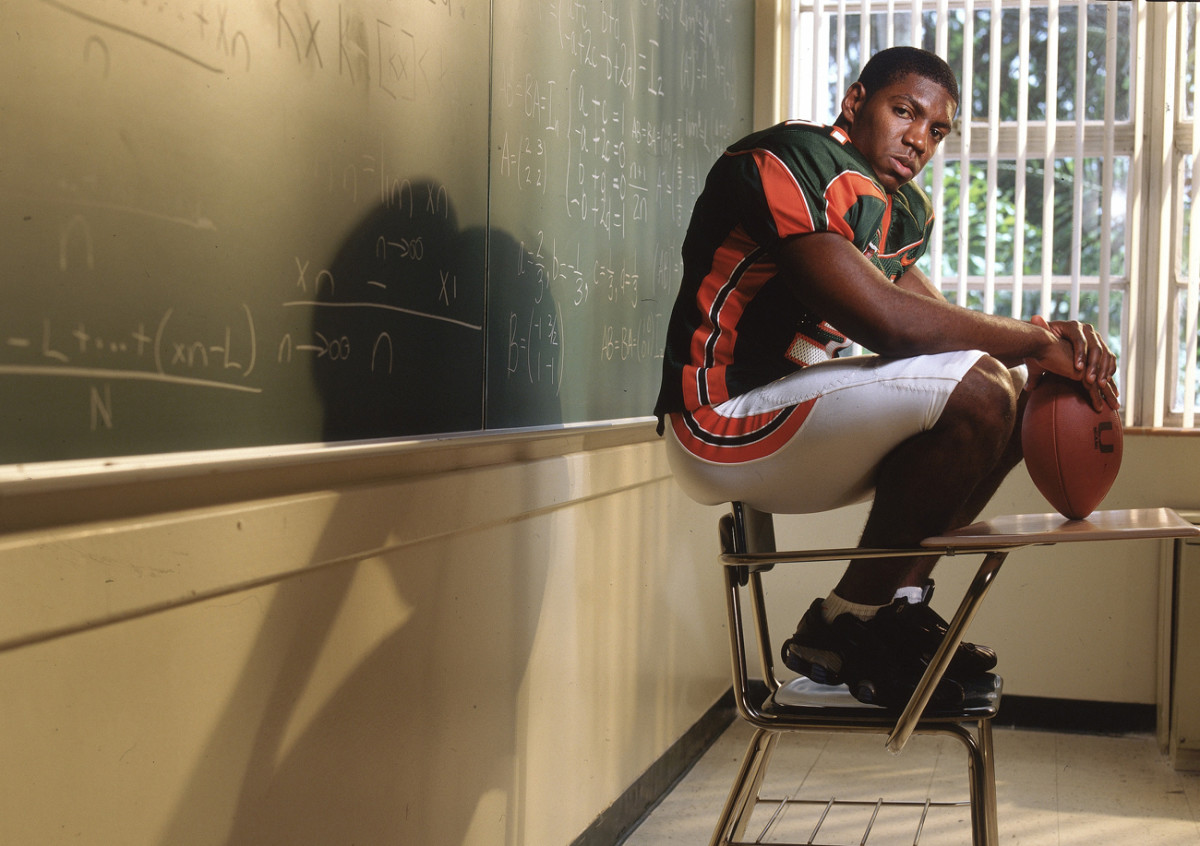
Vilma bought into the Regimen and gained five to ten pounds a year. He gradually got more athletic, too. Between his sophomore and junior year, in particular, Vilma noticed a big improvement in his speed and explosiveness. Those traits would help him compensate for his lack of size. “That’s what made me a first-rounder,” Vilma says.
Sitting across from Herm Edwards, Vilma told him he weighed maybe 223, 225, and that he could bulk up to 230 if need be. Edwards responded, No, don’t do that. Go back down to what you played at your senior year. That’s what I want. He’d watched plenty of tape on Vilma. That’s the player he wanted in the middle of his defense. In fact, Edwards had a crush on all three of the Miami linebackers. He told them that day: I’m taking two out of the three of you. “He was dead serious about it, too,” Vilma says. Edwards stayed true to his word: He nabbed Vilma in the first round, and McClover in the seventh.
No. 12, New York Jets: Jonathan Vilma, linebacker
After the Jets chose Vilma, D.J. Williams wasn’t exactly sure where he would land. At one point in the draft process, Bill Belichick had come down to Miami to work out Vilma and him together. They were two different types of linebacker. Vilma was more the cerebral team-leader, Williams the better athlete. When he was a freshman, the coaches had used Williams at fullback, just to get him on the field, as he waited his turn at linebacker.
Belichick put Vilma and Williams through about 45 minutes of drills. He didn’t film anything, didn’t bring an entourage of scouts or coaches—just his son Steve, who was around 17 at the time. In typical Belichick fashion, the Patriots coach didn’t say much throughout the workout, either. Once it ended, he simply thanked the two players and walked off.
“We were like, what the hell just happened?” Vilma recalls. He and Williams had no idea whether Belichick was actually interested. It turned out he would never get a chance to draft either of them.
Shortly after Vilma went at 12, Williams received a phone call from the Saints, who owned the 18th pick. “They had looked at all of the teams ahead of them, and nobody needed a linebacker,” Williams says. They told Williams they were drafting him.
At his draft party, in a players lounge at the Miami football facility, everyone started celebrating. This seemed like the perfect landing spot: Donte Stallworth, who Williams calls his cousin, already played for the Saints. Williams phoned Stallworth, and he raved about the organization. Williams’ family started brainstorming people they knew in New Orleans, and which games they’d attend. “We’re talking about beads and Mardi Gras and gumbo,” Williams says.
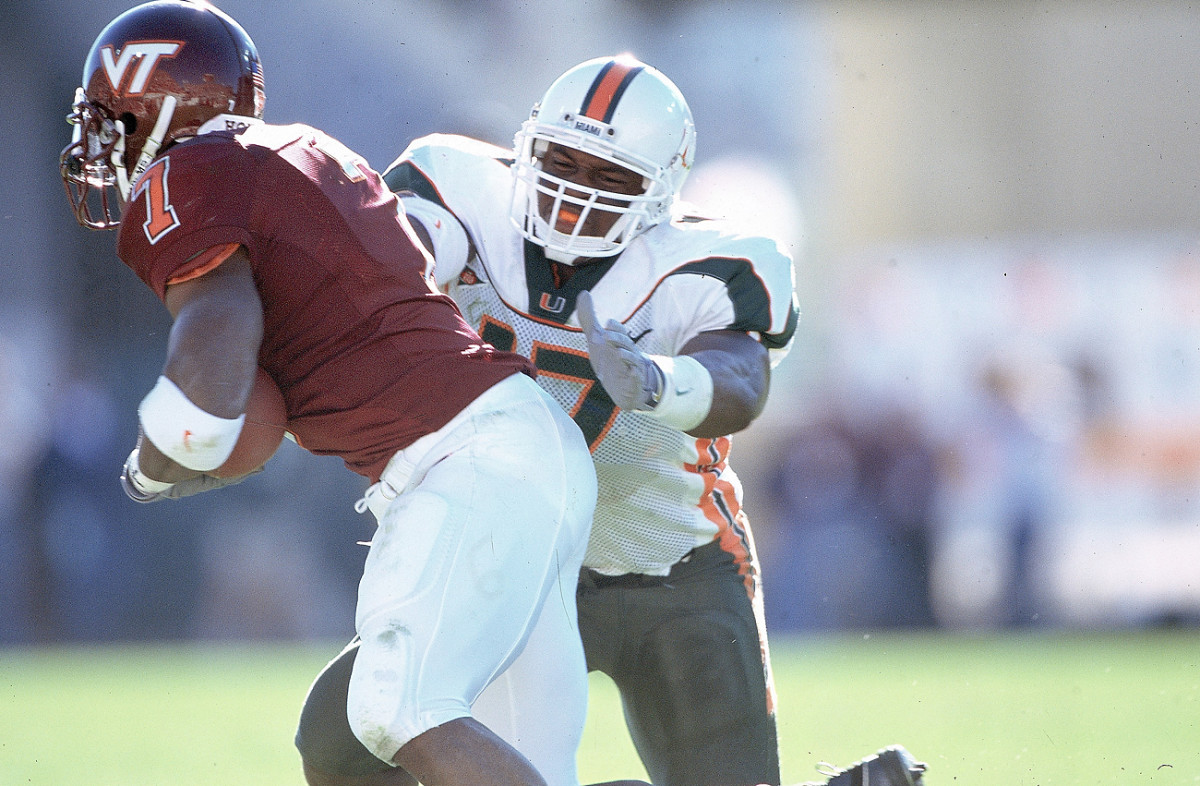
He remembers being on the phone with the Saints when his agent, Tony Fleming, told him that the Broncos were on the other line. “I looked at him like, ‘O.K.? I’m going to the Saints. They already said they’re going to draft me,’ ” Williams says. “He was like, ‘No, you’ve got to take this call.’ ” Denver owned the No. 17 pick, one spot ahead of New Orleans. Williams put the other phone to his ear: How would you like to be a Denver Bronco? Then he saw his name flash across the TV screen.
Williams asked his agent, What’s going on here? Do I have to go to Denver?
Yeah, you kind of have to, Fleming replied.
Williams was confused by the Broncos’ interest, and apparently so were the Saints. A few weeks earlier Denver had traded cornerback Deltha O’Neal to the Bengals to move up seven spots in the draft, into that No. 17 slot. Even so, Williams thought Denver was set at linebacker. The Broncos had two Pro Bowlers in Ian Gold and Al Wilson and a former All-Pro in John Mobley.
But Mobley had suffered a spine injury the previous season that would eventually end his career, and Gold was a free agent. After drafting Williams, the Broncos would let Gold sign with Tampa Bay. This was the NFL’s circle of life, in action. A young linebacker comes in, and an older, more expensive one is shown the door.
Williams was curious about his new team, so he tapped into the Miami alumni network. He spoke to Portis, who’d played the previous two seasons in Denver. “He didn’t help the situation,” Williams recalls. “He was like, ‘Man, it’s cold up there. It snows. I know you like to party and hang out: Everything closes at 1 o’clock.’ I was just like, ah man.”
At 18, the Saints chose Will Smith, an Ohio State defensive end, and the dream was over. “If you look at my draft pictures,” Williams says, “I wasn’t that happy.”
No. 17, Denver Broncos: D.J. Williams, linebacker
Across town, Vernon Carey, the Hurricanes’ 6’5”, 335-pound offensive lineman, had tuned into the draft around the same time Williams was picked. For his draft party, Carey had rented out B.E.D. Miami, a South Beach dance club decorated with king-sized beds and white drapes. Carey had grown up in nearby Liberty City, and he’d invited 75 of his family members, coaches and friends to come celebrate with him. He spent the first half of the draft mingling with all his guests. His agent had told him he’d probably be picked somewhere between 19 and 32, so he didn’t start keeping track until pick 16.
Carey had long expected to be in this position. Coming out of high school, he was one of the top recruits in the country—and the status may have gone to his head. “Vernon was a highly, highly sought-after recruit,” says Swasey, the strength coach. “Being all over the country eating on every trip—by the time he showed up, it was like, damn. He was up to 380-something, I think. I mean, he was heavy.” As a result, Carey redshirted his first year and mostly served as a backup the following two seasons.
Around that time, Carey received two wake-up calls. First, his girlfriend gave birth to their first child, a boy they named Vernon Carey Jr. Then he watched the Minnesota Vikings draft his Miami teammate Bryant McKinnie at No. 7 overall in 2002.
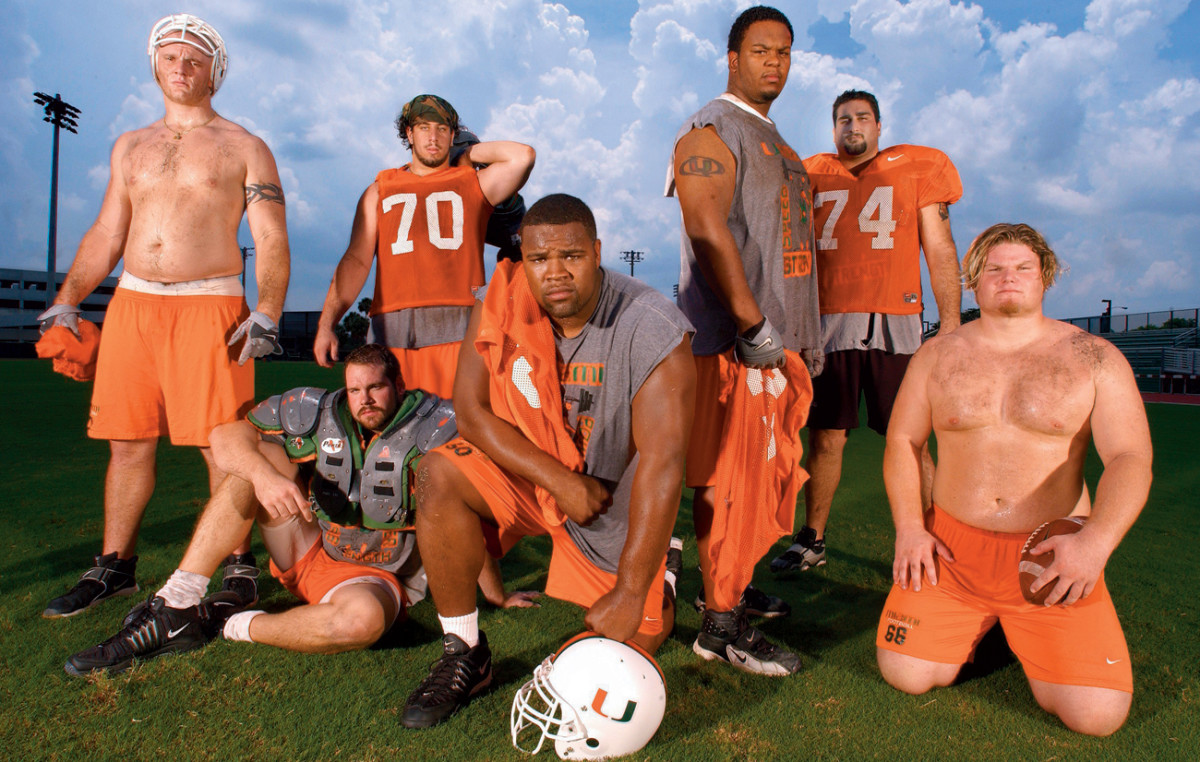
Carey and McKinnie were close friends. The two had arrived at Miami the same year (Carey as a freshman, McKinnie as a JUCO transfer), they were both mammoth offensive linemen, and they lived next to each other in the dorms. On the field, Carey says: “I learned everything from him.” Off the field, he says: “We always partied together.” Seeing McKinnie get drafted that high gave Carey a little extra motivation. As Swasey puts it, “He realized, Dang, man, with the money Bryant was getting …”
At Carey’s draft party, McKinnie was there at his side. A day or two before, McKinnie had told Carey that Mike Tice, the Vikings coach and offensive line enthusiast, had been asking about him. I think we’re going to get you, McKinnie had said.
Lo and behold, as the Vikings’ pick at No. 19 approached, they called Carey. He and McKinnie were going to be teammates. Then the Vikings said, hold on, let us call you back. Next thing Carey knew, the Dolphins were calling him. They had traded a fourth-round pick to the Vikings to move up one spot and draft him. The Vikings dropped back a spot and took Kenechi Udeze, a USC defensive end, who would apparently fill one of their needs.
Carey would come to realize later on it was probably for the best that he and McKinnie weren’t reunited as teammates. “It would’ve been fun,” he says. “We probably would’ve had too much fun.”
No. 19, Miami Dolphins: Vernon Carey, offensive tackle
The last of the six Miami first-round hopefuls was Vince Wilfork, the big defensive tackle, and he appeared to be sliding in the draft. Wilfork had expected to go No. 14, to Chicago, but the Bears had instead gone for Tommie Harris, the Oklahoma defensive tackle. Harris was quick and athletic; Wilfork was short and stocky and considered more of a run-stuffer. Wilfork was listed at 6’1”, 323 pounds—and that was apparently after he had dropped 20 pounds leading up to the draft. Some evaluators still seemed to have questions about Wilfork’s weight.
“I felt really comfortable with Chicago,” Wilfork told a reporter from The Palm Beach Post that day. “Once I saw they didn’t pick me, I got frustrated. I was wondering how much longer I’d be waiting.”
As Wilfork slid, he tried to put on a good face for the sake of his guests. He had turned his draft party into a charity event, inviting the general public, some of his teammates and an ESPN camera crew to join him at GameWorks, a local arcade bar, as he waited to be picked. “Big Daddy Draft Day Fest,” he called it. According to the South Florida Sun-Sentinel, Wilfork signed autographs, hosted a silent auction and raised more than $10,000 for diabetes research. He vowed to match that amount once he signed his contract.
Wilfork chose the cause for a specific purpose. Both of his parents had died in 2002, during his sophomore year. His father had diabetes and reportedly died of kidney failure in June, and then his mother died from complications from a stroke that December.
At the time, Randy Shannon, the Hurricanes’ defensive coordinator, worried about Wilfork’s health, too. Wilfork had been heavy from the time he arrived at Miami, tipping the scales are more than 300 pounds. Back then, the Hurricanes had such a talented defensive line that Shannon rotated players frequently, so everyone played about 35 to 40 snaps a game. In theory, the rotation was designed to keep bigger defensive tackles like Wilfork fresh. But during his freshman year Wilfork would frequently ask Shannon for more snaps.
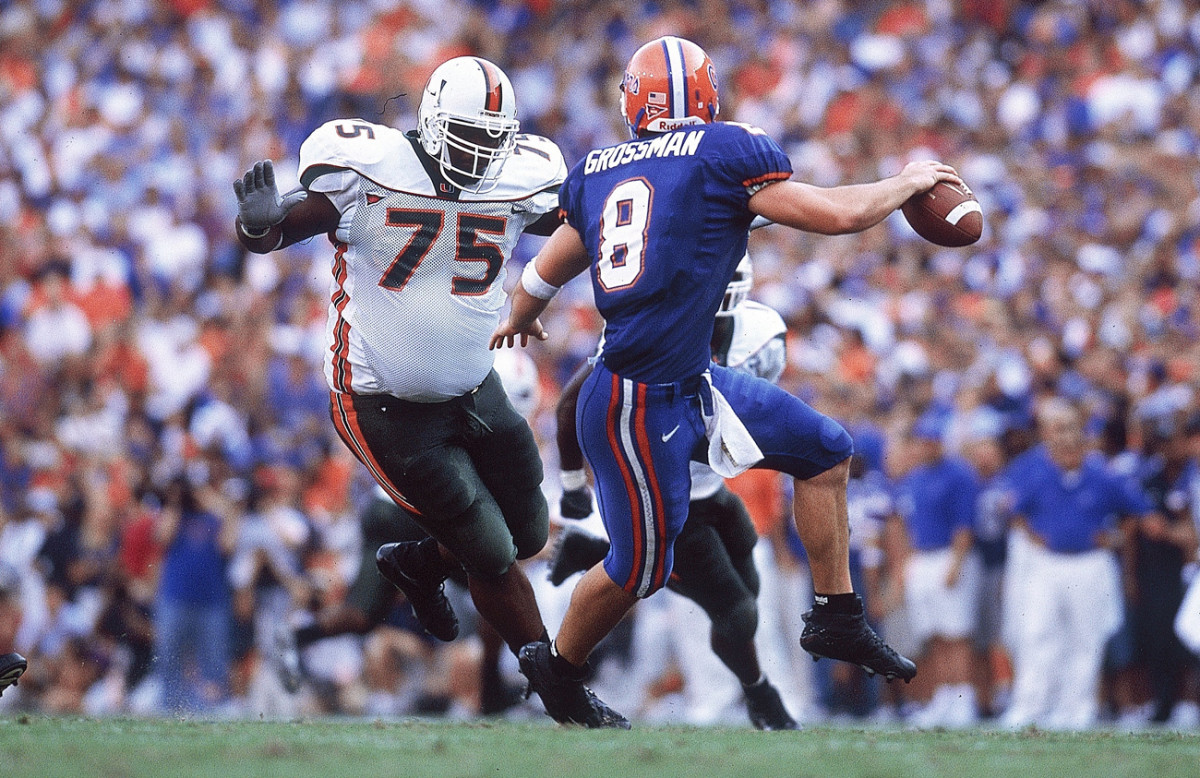
So Shannon decided to teach Wilfork a lesson. When Miami jumped out to a big lead at Florida State, Shannon says he kept Wilfork in for the entire second half. He estimates that Wilfork played 65 snaps that game. On the plane ride back to Miami, Shannon found Wilfork laid out, exhausted. “You got me on that one,” he told Shannon, admitting defeat.
After the death of Wilfork’s parents, Shannon began talking to him about making some lifestyle changes. They would take long walks together around the Miami campus, and in the morning they would eat Raisin Bran cereal together. “Just showing him a new way of eating, controlling his diet,” Shannon says. “Cutting back on the cholesterol intake, those things.”
Wilfork decided to go pro after his junior. He was still round by then, but rock solid, like a bowling ball. “I mean, you couldn’t pinch as much fat off him as you thought,” says Swasey, the strength coach. “He was pretty lean for a big guy. Calves and legs. He carried it in his stomach, but other than that he didn’t have a lot of fat. He just had that gut on him.”
The Patriots finally ended Wilfork’s slide, taking him with the 21st pick. Wilfork would replace the Ted Washington, the 365-pound nosetackle who had left New England in free agency. Belichick viewed Wilfork as a good fit in his scheme, a bowling ball in the middle of his 3-4 defense. Afterward, Wilfork told the Palm Beach Post, “God has a reason for everything, I guess.”
No. 21, New England Patriots: Vince Wilfork, nosetackle
Later that night, after the first round had ended, Vilma and Williams hosted a party at Nikki Beach, a popular club in South Beach. They had a large VIP space reserved for all of their friends. Two fellow 2004 first-rounders, Sean Taylor and Vernon Carey, showed up, as did a number of current and former Miami Hurricanes, some of whom were already, or would later become, first-round picks.
“Who showed up? I have no idea,” Williams says.
It was that kind of night. Williams does remember wearing a shirt from Chappelle’s Show, which was at its peak in 2004. The shirt featured an image of Dave Chappelle in handcuffs, holding a wad of cash. The caption read: I’M RICH BITCH.
In the years to come, these six first-round picks would take very different paths.
• In Washington, Taylor quickly established himself as one of the best young players in the game and a model of the hard-hitting NFL safety. Midway through his fourth season, however, tragedy struck. In November 2007, Taylor was shot by intruders in his Miami home. His death stunned the football world. Today Taylor is admired by an entire generation of young safeties. “I think he would’ve been a Hall of Fame candidate if he’d lived long enough,” says Butch Davis.
• Winslow’s first two years in Cleveland were marred by injury—he suffered a broken leg in Week 2 of his rookie year, and the following May he tore his ACL in a motorcycle accident, forcing him to miss the 2005 season. When finally healthy he had some productive seasons in Cleveland and Tampa, before his career fizzled out in 2013. In recent years he’s been arrested for a slew of crimes, including burglary and kidnapping. His trial on rape charges is scheduled to begin later this month.
• Vilma won the Defensive Rookie of the Year award with the Jets, but a few years later, they traded him to the Saints, the team that had missed out on Williams in the draft. Vilma won a Super Bowl in New Orleans, and was later chosen to the team’s Hall of Fame. In 2012 the league accused him of being a central figure in the Saints’ Bountygate scandal and suspended him for the season, a decision that was vacated on appeal. Vilma retired in 2013 as a three-time Pro Bowler.
• Williams played nine years in Denver, braving the cold weather, and was a reliable starter for most of that period, though off-field incidents, including a pair of DUIs, marred some of his time there. He then spent two years with the Bears and retired after the 2013 season.
• Carey had a lucrative but unspectacular nine-year career playing for the Dolphins. He says that that money helped him provide for his family and “give them a life that I never had.” His son Vernon Carey Jr. is now a top basketball prospect who’s committed to play at Duke next season; he’s expected to be a top pick in the 2020 NBA draft.
• Of those six first-round Hurricanes from 2004, Wilfork, the last one to be picked, may have had the best career. Over 11 seasons in New England, he made five Pro Bowls and won two Super Bowls. When he retired in 2017, Belichick said that seeing him available at No. 21 in that draft was “one of the real surprises” of his career. The coach also called Wilfork “as good a two-gapper as has probably ever played in this game.” He might have a shot at the Hall of Fame someday.
But back at Nikki Beach, in 2004, who could’ve predicted all that? Back then they were just starting out. They were the greatest draft class ever, and they had the world at their feet. Williams remembers partying well into the night, without much consideration for his early morning flight to Denver the next day.
“I was on the plane huuuung over.”
Question or comment? Email us at talkback@themmqb.com.
